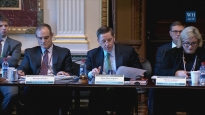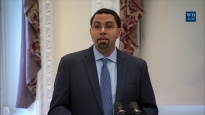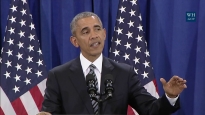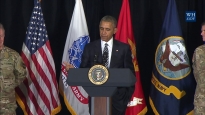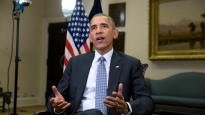The First Lady Unveils Childhood Obesity Task Force Action Plan
May 11, 2010 | 46:07 | Public Domain
First Lady Michelle Obama joins Domestic Policy Council Director Melody Barnes and members of the Childhood Obesity Task Force to unveil the Task Force action plan: Solving the Problem of Childhood Obesity Within a Generation.
Remarks by the First Lady at "Let's Move" Action Plan Announcement with Cabinet Secretaries
10:40 A.M. EDT
MRS. OBAMA: Thanks, everyone, and thanks, Melody, for that kind introduction, that wonderful summary.
I want to thank Melody in particular for her work with this administration, especially her leadership on this Task Force.
As I said when we announced the Task Force effort, this is going to have to be an administration-wide effort. And I am proud of the way that so many people from so many different areas of the federal government have come together and embraced this challenge, stepped up with a level of commitment and passion that’s really made a difference.
If we -- just take a step back for a moment and think about just how much this group has been able to accomplish in such a short period of time. In just a few months, the folks behind me have worked together to put forward a comprehensive plan that draws on everything that we’ve done up to this point and shows us that clear way forward.
That cooperation, enthusiasm and initiative is really what has made this entire effort so successful. And again that’s why we’re here today –- to talk about the action plan they’ve put together to help reverse the epidemic of childhood obesity in this country. We all know that it’s possible. We know we have the tools, we know we have the resources to make this happen. And now, thanks to the work of the Task Force, we have a road map for implementing our plan across our government and across the country.
I have talked about the statistics. We have all heard about them. But they always bear repeating. How nearly one in three children in this country are overweight and obese. How one in three kids will suffer from diabetes at some point in their lifetime as a result. And how we’re spending $150 billion a year to treat obesity-related conditions like heart disease and cancer.
That is why, three months ago, we started “Let’s Move” and we set a very ambitious goal -- and that is to end the epidemic of childhood obesity in a generation, so that children born today grow up at a healthy weight.
And since we’ve made that announcement, we’ve already begun the work. It’s revolved around four main pillars. We’ve been working to give parents the information that they need to make healthy decisions for their families. We’ve been working to make our schools healthier. We’ve been working to increase the amount of physical activity that our kids are getting, not just during the day at school but also at home. And we’re working to eliminate “food deserts” so that folks have easy and affordable access to the foods they need right in their own neighborhoods.
But all that we've done over the past few months has really just been the beginning. We also want to make sure we’re using every resource that we have -- not just in our federal government -- but throughout the public and private sector, as well. We are calling upon mayors and governors; and parents and educators; business owners and health care providers -- anyone who has a stake in giving our children the healthy, happy future that we all know they deserve.
And as I’ve said before, we don’t need new discoveries or new inventions to reverse this trend. Again, we have the tools at our disposal to reverse it. All we need is the motivation, the opportunity and the willpower to do what needs to be done.
That’s why, shortly after we started “Let’s Move,” we asked the Task Force to collect ideas and to put together a road map for what we need to do moving forward.
But we’ve also known, as Melody pointed out, from the very beginning that the solution to this epidemic isn’t going to come from just Washington alone. Not a single expert that we’ve consulted has said that having the federal government tell people what to do is the way to solve this.
That’s why the Task Force has done such a great job in reaching out to people all across the country for their ideas, as Melody has pointed out, and we’ve got terrific responses and input which has really helped to shape this report.
Today, the Task Force has submitted their report outlining important steps that federal agencies and their partners -– including businesses and the private sector -– will take in the months and years ahead to help keep our children healthy. For the first time -- this is the key -- we’re setting really clear goals and benchmarks and measurable outcomes that will help tackle this challenge one step, one family and one child at a time.
The effort starts with using the resources across the federal government in the most effective ways possible -– not just talking about making a difference, but actually doing it. And that’s why I am so proud of the folks behind me because they’ve really taken the lead and stepped up in their agencies.
At the Department of Agriculture, Secretary Vilsack -- who couldn’t be here today, but Kathleen is -- is leading the way to first reauthorize the Child Nutrition Act, to get healthier foods in our schools, and to make sure that everyone in this country has access to healthy, affordable foods in their neighborhoods.
At the Department of Health and Human Services, Secretary Sebelius is working to provide mothers with better prenatal care, and to give parents and caregivers the information they need to make healthy decisions for their families.
At the Department of Education, Secretary Duncan is working to expand opportunities for physical activity in schools, and helping our children learn how to make healthy choices for themselves.
And at the White House, Nancy-Ann DeParle worked with Secretary Sebelius and so many others to help pass health reform, the bill that is a groundbreaking piece of legislation that includes really important provisions like requiring chain restaurants to post the calories in their food, and businesses to provide opportunities for working mothers to continue to breastfeed.
This report also contains these steps, but many others -– more than 70, as Melody pointed out -- including measurable benchmarks for tracking the progress. So if we do our jobs, and if we meet the goals we’ve set, we will reverse a 30-year trend and solve the problem of childhood obesity in America.
In order to make our kids maintain a healthy weight from the very beginning, we’re going to increase prenatal counseling, help pregnant mothers maintain a healthy weight. We’re also setting a goal to increase breastfeeding rates to help children get a healthy start on life.
To encourage children to eat healthier, we’re setting a goal to increase the amount of fruits that children consume to 75 percent of the recommended level by 2015. We want to increase that again to 85 percent by the year 2020, and then by the year 2030 we hope to be at 100 percent. We’re using a similar scale to increase the percentage of vegetables that our kids are eating as well. We’re also working to decrease the amount of added sugar that our kids consume from a whole range of products.
And to make sure that parents and kids are getting the right information that they need to make healthy decisions, we’re setting a goal that all primary care physicians should be assessing BMI at all well-child and adolescent visits by the year 2012. And we’re also working to increase the portion of healthy food and beverages that are advertised and targeted to our children so that within three years the majority of food and beverage ads aimed at kids will promote healthy choices.
We’re also setting benchmarks for our schools as well. We’ll be working, as I’ve said many times over the months, to double the number of schools that meet the HealthierUS School Challenge by the year 2011, and we want to add another thousand schools each year for the following two years. We’re also aiming to add an additional 2 million children to the National School Lunch Program by 2015.
And to help our kids stay active, we’re going to increase the number of high school students who participate in daily P.E. classes by 50 percent by the year 2030. And we’ll aim to increase the percentage of elementary schools that offer recess to 95 percent by the year 2015. Both these steps are aimed at boosting the number of kids of all ages who meet current physical activity guidelines.
To make it easier for parents to put healthy food on the table, we’re going to keep track of the low-income areas where residents live more than a mile from a supermarket or large grocery store, and for rural areas we’re tracking those that are more than 10 miles away. And we’ll set a goal of eliminating all those “food deserts” within seven years.
And to make it easier for kids to walk to school, we’re aiming to increase the percentage of school-age children who take safe walking and biking trips to school by 50 percent in the next five years.
In the end, that’s why this report, and this Task Force, are so important. We all know the dangers of childhood obesity, and the toll that it takes on our children, our families, and our country. We know the steps that we need to take to reverse the trend. Through “Let’s Move,” we’ve already started making some progress. We’ve gotten wonderful support from all sectors of our country.
And now, with this report, we have a very solid road map that we need to make these goals real, to solve this problem within a generation. Now we just need to follow through with the plan. We just need everyone to do their part -- and it’s going to take everyone. No one gets off the hook on this one -- from governments to schools, corporations to nonprofits, all the way down to families sitting around their dinner table.
And the one thing that I can promise is that as First Lady I’m going to continue to do everything that I can to focus my energy to keep this issue at the forefront of the discussion in this society so that we ensure that our children can have the healthy lives and the bright futures that they deserve.
So I am grateful to everyone here -- not just members on stage, but people in the media who have really done an outstanding job to continue to keep this issue at the forefront. We’re going to keep needing to have this conversation. Our work has just begun. This road map is just the beginning. But we’re going to continue to need your help in monitoring, tracking, having the important discussions that we need to inform families about what’s going on, how to make the changes that they need. It’s not going to be easy, but we’ll do our part to stick with families and communities and reach our goals.
So I want to thank you all for the support you’ve lended this effort. I’m very proud of our federal agencies, all our secretaries and our agency heads. Every single one of them has shown a passion. They’ve seen around the country that we’re poised to make a difference in this country, that people are ready for this change.
So with that, I’ll again thank Melody for her work in leading this very efficient and effective effort, and then we’ll open it up. These secretaries will answer questions. I will leave -- (laughter) -- but they’re very competent to get that done.
So thank you, all. Thank you, guys. Thank you. (Applause.)
END
10:54 A.M. EDT
|
December 7, 2016
|
December 7, 2016
|
December 7, 2016
|
December 6, 2016
|
|
December 6, 2016
|
December 5, 2016
|
December 4, 2016
|
December 3, 2016
|
- &lsaquo previous
- …
- 3
- 4
- 5
- 6
- 7
- 8
- 9
- 10
- 11
- …
- next &rsaquo

